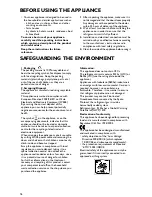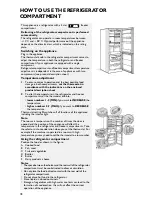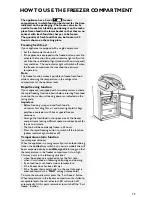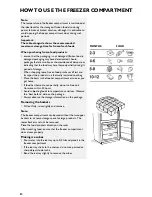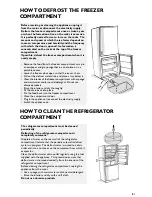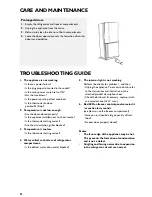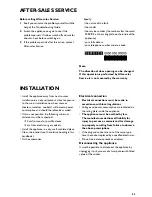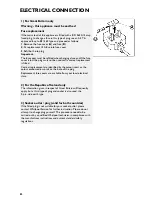
77
PRECAUTIONS AND GENERAL
RECOMMENDATIONS
INSTALLATION
• The appliance must be handled and installed
by two or more persons.
• Be careful not to damage the floors (e.g.
parquet) when moving the appliance.
• During installation, make sure the appliance
does not damage the power cable.
• Make sure the appliance is not installed near a
heat source.
• To guarantee adequate ventilation, leave a
space on both sides and above the appliance
and follow the installation instructions.
• Keep the appliance ventilation openings free.
• Do not damage the appliance refrigerant
circuit pipes.
• Install and level the appliance on a floor strong
enough to take its weight and in a place
suitable for its size and use.
• Install the appliance in a dry, well ventilated
place. The appliance is designed to operate in
areas where the temperature comes within
the following ranges, according to the climatic
class given on the rating plate.
The appliance may not work properly if it is
left for a long time at a temperature outside
the specified range.
• Make sure the voltage specified on the rating
plate corresponds to that of your home.
• Do not use single/multi adapters or extension
cords.
• For the water connection, use the pipe
supplied with the new appliance; do not reuse
that of the previous appliance.
• Power cable modification or replacement
must only be carried out by qualified
personnel or After-sales Service.
• It must be possible to disconnect the
appliance from the power supply by
unplugging it or by means of a mains two-pole
switch installed upline of the socket.
SAFETY
• Do not use the appliance to store aerosol cans
or receptacles containing propellants or
flammable substances.
• Do not store or use petrol, flammable liquids
or gas in the vicinity of this or other electrical
appliances. The fumes can cause fires or
explosions.
• Do not use mechanical, electric or chemical
means other than those recommended by the
Manufacturer to speed up the defrost process.
• Do not use or place electrical devices inside
the appliance compartments if they are not of
the type expressly authorised by the
Manufacturer.
• This appliance is not intended for use by
persons (including children) with reduced
physical, sensory or mental capabilities or lack
of experience and knowledge, unless they
have been given supervision or instruction
concerning use of the appliance by a person
responsible for their safety.
• To avoid the risk of children becoming
trapped and suffocating, do not allow them to
play or hide inside the appliance.
• Do not swallow the contents (non-toxic) of
the ice packs (in some models).
• Do not eat ice cubes or ice lollies immediately
after taking them out of the freezer since they
may cause cold burns.
USE
• Before carrying out any maintenance or
cleaning operation, unplug the appliance or
disconnect it from the power supply.
• All appliances equipped with an automatic
icemaker and water dispenser must be
connected to a water supply that only delivers
drinking water (with mains water pressure of
between 0.17 and 0.81 Mpa (1.7 and 8.1 bar)).
Automatic ice-makers and/or water dispensers
not directly connected to the water supply must
be filled with drinking water only.
• Use the refrigerator compartment only for
storing fresh food and the freezer
compartment only for storing frozen food,
freezing fresh food and making ice cubes.
• Do not store glass containers with liquids in
the freezer since they may burst.
The Manufacturer declines any liability if
the above advice and precautions are not
respected.
Climatic Class
Amb. temp.
(°C)
Amb. temp.
(°F)
SN
From 10 to 32
From 50 to 90
N
From 16 to 32
From 61 to 90
ST
From 16 to 38
From 61 to 100
T
From 16 to 43
From 61 to 110


